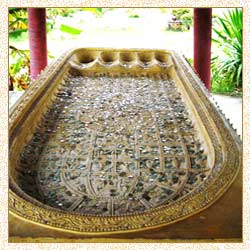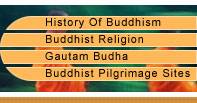 Buddhism symbols signify the Buddhist culture and religion. Most of the Buddhist symbols relate to the ancient period and are found in Hinduism also. These symbols of Buddhism impart subtle messages in life. They teach you how to live selflessly and have a contended life. In the following lines, we have provided information about the major Buddhist symbols...
Buddhism symbols signify the Buddhist culture and religion. Most of the Buddhist symbols relate to the ancient period and are found in Hinduism also. These symbols of Buddhism impart subtle messages in life. They teach you how to live selflessly and have a contended life. In the following lines, we have provided information about the major Buddhist symbols... Symbols for the Buddha
Lord Buddha was not very comfortable with accepting images of himself. This is because He never wanted to be respected as a person, but be known for His principles and His teachings. Still, the following symbols of Buddhism are used to signify Lord Buddha.
- Eight Spoked Wheel
- The Bodhi Tree
- Buddha's Footprints
- An Empty Throne
- A Begging Bowl
- A Lion
The Three Jewels or Triple Gems of Buddhism are the Buddha, the Dharma (his teachings) and the Sangha (monks and nuns). All of them make the base of Buddhism and without either of the three the religion wouldn't have been possible.
The Deer
The Deer is symbolic of Dharmachakra Parivartan, the first teaching of Lord Buddha in the Deer Park of Sarnath. As per the Tibetan tradition, a monastery having the Kangyur and Tengyur collections of texts has to have this symbol on both sides of the Dharma-wheel on the roof.
Stupas
The enlightened mind of Buddha is reflected through the stupas. Symbolically, stupas represent the following five elements:
- Earth - Represented by the square base of the stupa
- Water - Represented by the round dome of the stupa
- Fire - Represented by the cone-shape of the stupa
- Air - Represented by the canopy of the stupa
- Space - Represented by the volume of the stupa
There are eight offerings in Buddhism, those of water (to cleanse the mouth or face), water to wash the feet, flowers, incense, light, perfume, food and musical instruments. They are believed to educate people against greed and attachment.
The Seven Jewels of Royal Power
The Seven Jewels of Royal Power characterize different qualities of a king, which he must have for staying in power. They collectively symbolize the secular power and can be offered, symbolically, to the Buddha.
The Eight Auspicious Symbols
The Eight Auspicious Symbols of Buddhism, or the Ashtamangala, are related to the physical form of the Buddha. They include.
- A Conch Shell
- A Lotus
- A Wheel
- A Parasol (Umbrella)
- An Endless Knot
- A Pair of Golden Fishes
- A Banner Proclaiming Victory
- A Treasure Vase
Colonel Henry Steele Olcott, an American journalist, developed the Buddhist Flag in 1880. The five colors of the flag represent the colors of the aura that radiated from Buddha, at the time of His Enlightenment. The colors are:
Blue: Loving kindness, peace and universal compassion.
Yellow: The Middle Path - avoiding extremes, emptiness.
Red: Blessings of practice - achievement, wisdom, virtue, fortune and dignity.
White: Purity of Dharma - it leads to liberation, outside of time or space.
Saffron: The Buddha's Teaching - wisdom.
The Swastika
The Buddhist symbol of swastika signifies the feet or footprints of the Buddha and is often used at the beginning of texts.
Mountains
Buddhist symbolism consists of the following two key mountains.
Vulture Peak
Situated in northern India, it is the place where Lord Buddha delivered a number of sermons.
Mount Meru
It belongs to the Buddhist cosmology and is considered the mythological center of the Buddhist universe. It is also the link between hell and heaven.




